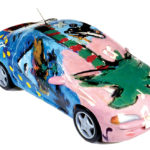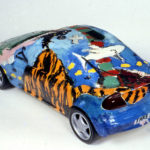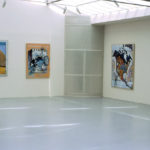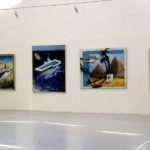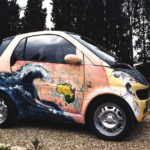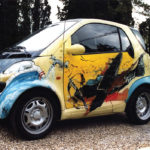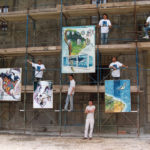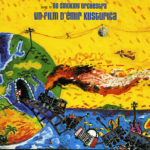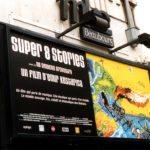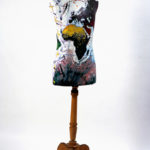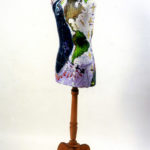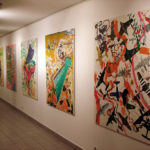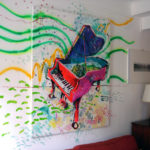Cartographies
SPACES and VASTNESS
By Alexandar Djuric, Art Critic and Artist
/Text for the exhibition catalogue in Zepter Foundation Gallery in Belgrade, 2001/
A number of favorable circumstances helped Bogdan Pavlovic to mould personal, original and mature visual language at the very beginning of his professional career as painter. However, that particular element is not characteristic of this author only. Other young and successful people have started from the same position. The thing that draws our attention and opens the door of our confidence in the future of this artist rests neither in the acquired nor in the inherited, but undeniable, visual literacy. Specific feeling for composition, color, tone, hue, stroke, perspective, implementation, is characteristic feature of all serious painting, and Bogdan Pavlovic has exemplary control over all of these constituents of the visual language. This should undoubtedly be attributed to hereditary factors, his education with eminent professors and the family environment focused onto art.
Nevertheless, they are not the clues to true understanding of his paintings. The enigmatic pictures themselves announce their extraordinary transparency spanned between the thematic and contextual layers of the work. Their motifs speak of their author’s inclination toward everyday issues, even war stories, seen through an innocent almost boyish eye. There is some postmodern irony in these scenes, but it originates in the artist’s sharp intelligence that perceives illusion and mocks it in a superior way.
The paraphernalia of his fanciful visual images belong to geographical maps, airplanes, swimming pools, ladders, zeppelins, washing machines, ships, and various animals. All this artifacts are frequently part of a single painting. However, the artist does not use collage technique, as one could expect, because it would facilitate the procedure of bringing real things into unreal relationships, leading further on to a corresponding speech. Although present, such effects are the priority of Pavlovic’s interest. It is more important for him to demonstrate within the sphere of human mind the mystery of inter-permeating expanses of heaven, water, earth, articulated in the space of his canvases. The primary experience of our eye relies on a three-dimensional image; on his expressively painted two-dimensional surfaces, Bogdan Pavlovic translates and condenses it into compact experience of a monistic essence of the world. I believe that beside all other values, this belongs to the highest achievements of these works. It is exciting to watch a real scene without perceiving where the original elements of the world end or begin, where they touch, mix interlace or overlap. Consequently, the forms that inhabit a visual space of such construction, where they represent the elements of expanse, must possess meaningfully open structures. Their contours are soft, permeable to colors, suggesting dynamism, movement, vibration. The paintings have become alive. At the same time, there is the issue of perspective or the overview of the author himself. Physical distance is not possible, because the clarity of detail and intensity of colors negate it. The standpoint from which Bogdan Pavlovic reflects upon the world lies within the being, on the spot where child is father to man. Everything is in equilibrium there: both, the real and imaginary, serious and silly, factual and impossible. Chagall’s metaphysics of the painted space has been realized, but in a postmodern solution.
Is there a greater compliment for a painter who has only stepped onto the path of artistic perseverance and persistent reaffirmation?
___________________________
CARTOGRAPHIES
Par Florence Touber
Galerie Florence Touber, Paris, 2000
Il s’appelle Bogdan Pavlovic et à la manière d’un explorateur, visite la carte du monde.
“Cartographies” est le titre de son exposition à la Galerie Florence Touber du 29 novembre au 6 janvier.
Jeune artiste de 31 ans, d’origine Serbe, il entre à l’Académie des Beaux Arts de Belgrade en 1989 et achève sa formation à l’Ecole Nationale Supérieure des Beaux Arts de Paris ou il fait partie de l’atelier Velickovic. Le Prix des Artistes du Monde, le Prix spécial du trophée de la couleur etc.… lui on valu en tant que lauréate, des expositions de son travail précédent notamment a la Fondation Coprim.
Intéressé des son plus jeune âge par les éléments constitutifs de l’univers – la terre et ses habitants, l’eau et le feu – ainsi que par les sciences qui en découlent – astronomie, la biologie, l’écologie – Bogdan Pavlovic donne aujourd’hui à voir son monde référentiel. Il est constitué de cartes du monde et du ciel, de pays lointains et fabuleux, de volcans en éruption, d’océans, de végétations luxuriantes, de mondes médiévaux mais aussi d’avions et d’éléments technologiques propre à notre époque.
A l’huile sur toile, ces tableaux très en matière sont autant d’allusions aux thèmes chers au peintre. Il évoque tour à tour l’exploration ingénue de l’homme, les catastrophes écologiques, l’absurdité de la guerre. Comme les mures des graffitis, ces toiles portent aussi des graphies, parfois en cyrillique.
Son travail fait référence au monde imaginaire de l’enfance, créateur de lieux fantastiques et inconnus. L’adulte Pavlovic n’a pas oublie Jules Verne. Les couleurs vives, presque crues de ses toiles, rappellent celles des jouets d’enfants et des cartes géographiques aux mures des salles des classes.
Mais ces cartes sont aussi celles du monde d’aujourd’hui, un monde inquiet bruissant de langues et de risqué, de tempêtes possible liées aux hégémonismes et aux phénomènes naturels. Le propos alors n’est pas politiquement correct: n’est elle pas fascinante cette montée en puissance de la mare ici, du rappel identitaire la.
Reste qu’elle est pittoresque. Tableau après tableau et avec verve d’un Combas, Bogdan Pavlovic s’exclame peut-être après Apollinaire: “Dieu que la guerre est jolie!“
____________________________
“Bogdan Pavlović”
Jovan Despotović, Head of the Museum of Contemporary Art in Belgrade,
Third Program of Radio Belgrade, Belgrade, 13th May 2005
This is how art critic Jovan Despotović described Pavlović’s opus:
“One of definitely most interesting and outstanding phenomena in Serbian fine arts in the second half of the 1990s was Bogdan Pavlović (…) In order to raise the scenes initiating interest in these planetary problems to the highest possible level of visual persuasion, intrigue, provocation and attraction, Pavlović uses not only the palette of clear colours but also textual and illustrated newspaper cuttings, comic strips (the ones he draw himself but also ‘copies’ from other authors), writes slogans, draws real and imaginary maps of continents, sticks reproductions of some masterpieces from history of art and so on. By simultaneous use of all these means Pavlović manages to raise the general scenic quality of drawings and paintings to a very high level and, in doing so, he actually attracts general attention of spectators and, finally, motivates them to deepen awareness of those topics he is also preoccupied with.”
_________________________
Geography of Spirit
By Vukica Nikolić
Art Life (Likovni život) No. 89/90, February 2001
Synchronous to contemporary artificial impulse and dynamic youthful pulse, Bogdan Pavlović’s painting consequently follows the exploring spirit, the penchant for adventure, documentary and illustrative qualities of modern media, tradition of National Geography Magazine or art-illustrated tourist brochures such as Destination’s, outlining the spirit of POSITIVE GEOGRAPHY while revealing more complex semantic levels and coordinates by its “meridian” vocabulary.
By his allusive program title of picture “Calling-London-calling”, messages such as “Her Majesty’s Swimming Pool”, inventive transposition of Falkland and Canary Islands or “Time Gap” and other spatial, ideological and cultural differences, Pavlović introduces percipients into visual and thought “confrontations” which give a skillfully conceived engaged meaning to scenes in his pictures, besides their seemingly entertaining character.
Through post-modernist synthetism of pop-art, illustrative and topographic cartography, constructive separate and disparate elements, expressionism of so-called New Picture as well as factual and metaphoric invention, Pavlović humorously/critically uses the SUBTEXT or OVERTEXT, narrative and well-conceived articulate poster-pictorial, sign-symbol iconography, cultivated composition and material structure to achieve the perfect transparency of the picture and the visual and contextual correlation. Moreover, the author emphasizes the particularity principle as a stimulus for logical construction of the picture (pars pro toto), by which he animates the postmodernist PLAY, transposing it into a lucid SYNOPSIS of spatial modalities, activated by birds, ships, airplanes, airships, “Carriers” of steel birds – coordinated by the perspective of GEOGRAPHY OF SPIRIT and CARTOGRAPHY OF IMAGINATION.
_________________________
Making an adventure of the everyday
By Vanja Savic, JAT Review, 2005
As postmodernism began to eradicate pure abstraction, the artist began to destroy the hidden creation behind his work and openly express his personal motivation. Through his works on paper, Bogdan Pavlovic returns to his childhood – though with the creativity of a mature and well read artist, conscious of the problems of the modern world and its surfeit of information. This explains the importance of his planetary, geographic, political, economic, ecological and navigational themes. At the exhibition in the Chaos Gallery, Pavlovic displayed not only his inner self but a collection of the works that he created over the last ten years. In short the artist epitomizes the gallery’s motto: “Chaos is the origin of everything”.
As art historian Lidija Merenik put it, Pavlovic’s paintings are more product of the French environment than the Serbian milieu. Epithets that critics most commonly attach to Pavlovic’s work include: exemplary of the relaxed painting of the 1980s, humoristic, reminiscent of the comic book style, adventurous, extremely imaginative, gifted in terms of expressive application and artistically engaging in terms of the artist’s input.
“I create an art that is connected to fiction, and which is reflection of the things that surround us. I start from myself – and I am convinced that the modern man has expressed the need to travel and to get know now different places and spheres of life in order to know himself better.” – explains Bogdan Pavlovic

